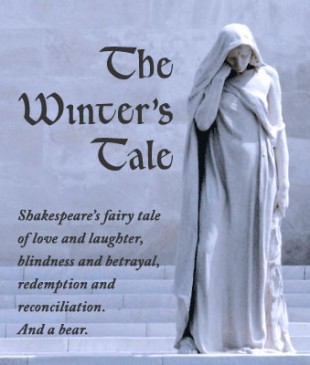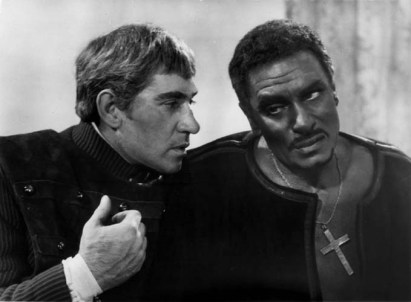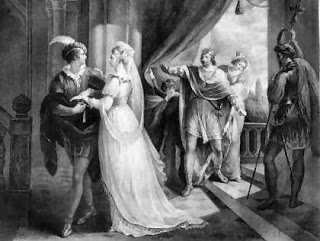In The Winter’s Tale, Shakespeare has created a play that draws together many of the themes of the great tragedies, particularly King Lear, Hamlet and Othello. As well, the female characters in this play also look back to Ophelia, Cordelia and Desdemona.
The plot
At the beginning of The Winter’s Tale, Polixenes, the King of Bohemia is visiting Leontes, the King of Sicily and his boyhood friend. During the visit, Leontes is overcome by jealousy and convinces himself that his wife, Hermione, is carrying Polixenes child. To avoid Leontes’ murderous anger, Polixenes returns to Bohemia accompanied by Camillo who had been charged, by Leontes, with murdering Polixenes .

Leontes throws Hermione into prison where she delivers a baby girl. Despite the pleadings of Paulina, Leontes orders Antigonus, Paulina’s husband, to abandon the baby girl, Perdita, in the wilderness.

Antigonus takes Perdita to Bohemia where, for his troubles, he is eaten by a bear. Perdita is rescued and raised by shepherds.
At her trial, Hermione collapses on learning that her son, Mamillius, has died of grief at his mother’s imprisonment. She is whisked off stage by Paulina. Leontes is haunted by the deaths of his wife, son and daughter.
Sixteen years pass and Florizel, Polixenes’s only son and heir, has met and fallen in love with Perdita.

Perdita by Anthony Frederick Augustus Sandys
On learning of his son’s plans to marry her, Polixenes disowns Florizel who flees to Sicily with Perdita where they throw themselves on the mercy of Leonties.
Polixenes follows Florizel to Sicily where it is revealed to Leontes that Hermione is not dead but has been living in seclusion for sixteen years and that the young woman accompanying Florizel is his daughter, Perdita.

A mid-19th century painting of the statue of Hermione coming to life.
This is followed by general rejoicing and forgiveness.
Commentary
This is not one of Shakespeare’s greatest plays. It is one of the late tragi-comedies: Pericles, Cymbeline and The Tempest being the others. It’s been said that in these plays, Shakespeare revisits some of the themes of his great tragedies and seeks to find a dramatic solution (and resolution) to the tragic and human consequences of those plays.
However, when this play revisits some of the themes and ideas of the great tragedies, the effect is rather less satisfying than both an emotional and dramatic sense.
The most notable of these is the examination of the consequences of jealousy and suspected infidelity that is played out in Othello. In The Winter’s Tale, Shakespeare poses the question: Is it possible to recover from the catastrophic effects of delusional jealousy? Unlike Othello, The Winter’s Tale says yes. But the dramatic resolution that is presented in this play is less dramatically and emotionally satisfying than in the great tragedy.

Frank Finlay as Iago and Laurence Olivier as Othello (1965)
In The Winter’s Tale, we see destructive jealousy overcome by Leontes’ penance and Paulina’s good offices. But why? Paulina’s husband has been eaten by a bear while carrying out Leontes insanely jealous wishes to destroy his daughter. Why would she wish him well?
Now, of course, there are answers to this question. Most particularly, that Paulina is one of Shakespeare’s great female characters who wishes to support another who has been strong in the face of the most unreasonable behaviour that you could possibly imagine: unjustified accusations of adultery. Nonetheless, there is nothing in the text to support this particular view.
The Winter’s Tale also revisits the theme of parental blindness that is played out in King Lear. The ending of The Winter’s Tale lacks the savage catharsis of King Lear. It certainly lacks the terrible beauty of the poetry in the final scenes of the great tragedy.
But Lear’s reunion with Cordelia has an emotional and dramatic scale far beyond that of Leontes’ reunion with Perdita. If there is forgiveness and reconciliation at the end of The Winter’s Tale, then it is muted and subdued and shot through with sadness at the knowledge that the past cannot be undone.
There are other similarities between the two plays. Perdita and Cordelia are very similar characters, particularly in relation to their dramatic function within the plays. Both have been grievously wronged by their father, both bring healing, reconciliation and forgiveness at the end of play.
There is another echo from King Lear. Paulina plays a role very similar to the fool in King Lear. She is mercilessly excoriating in her attacks upon Leontes and he accepts them as a punishment for the wrong that he has done his family. But Paulina is a realist and her attacks on Leontes lack the dramatic and bitter irony of the fool’s attacks on Lear.
There are also echoes from Hamlet, particularly in the scene where Perdita distributes flowers at the bacchanalian wool shearing scene that will conjure up memories of Ophelia’s distribution of flowers in Hamlet.
Ophelia: .There’s fennel for you, and columbines.—There’s rue for you, and here’s some for me. We may call it “herb of grace” o’ Sundays.—Oh, you must wear your rue with a difference.

Benjamin West’s depiction of Ophelia distributing flowers
The echoes of this tragic scene are picked up in The Winter’s Tale:
Perdita: For you there’s rosemary and rue; these keep. Seeming and savour all the winter long: Grace and remembrance be to you both. And welcome to our shearing!

These parallels tend to highlight some of the of the central problems with this play.
In many ways, it’s a fairytale with a changeling princess (Perdita), a prince with a hidden identity (Florizel), a fairy godmother (Paulina) and statue that comes to life (Hermione) and of course a fairytale ending.
But there’s a lot of dramatic conjuring in the resolution of this human tragedy. The audience is entitled to say “If we’re going to have fairytales, then they are better for being psychologically consistent and believable.”
There are a number of elements that don’t quite ring true.
There is nothing in the play to explain Paulina’s motivation in hiding Hermione away for sixteen years and for her merciless attacks on Leontes. Certainly he deserves it, but for sixteen years?
The problem is that Shakespeare needs sixteen years to pass for Perdita to grow up and Perdita and Florizel are essential to the happy ending.

Tom Bateman as Doricles/Florizel and Jessie Buckley as Perdita
But this is simply a dramatic device that leads to a resolution of the dilemmas of play but it presents problems particularly in relation to the motivation of Hermione and Paulina.
Beneath these particular details of the similarities between this play and the great tragedies, there is a question: “Is Shakespeare returning to ideas of the great tragedies and finding resolution and reconciliation, albeit within the structure of the fairytale, or do we see a great dramatist whose creative skills are in decline who is now reworking and revisiting old ideas but without the dramatic energy and skill of the earlier plays?”
Many of the people who see this play will have read or seen many, if not all of the tragedies, so that references to earlier plays and the ethical and human dilemmas that they examine will be clear to many members of the audience. So comparisons will be inevitable.
The dramatic role of the clown, Autolycus, is a case in point. There are funnier clowns in other plays and often these clowns will have important dramatic role to play. But this is not the case with Autolycus.

Autolycus (1836) by Charles Robert Leslie
He’s an entertaining rogue, vagabond, pickpocket and song and dance man but that’s it. He is a diversion and really has no, or little, dramatic impact on the play. He is a bit like the sheep-shearing party which is overly long and provides the audience with singing and dancing but does little else to justify the amount of stage time it has.
On balance, it doesn’t work all that well. The structure of the play, particularly the sixteen year gap in the middle exposes too many of the inconsistencies in the plot such as Paulina’s motivation for not explaining Leontes’ grief to Hermione.
At the end of the play, we get the first hint of Pauline’s grief.
Paulina: I, an old turtle,
Will wing me to some wither’d bough and there
My mate, that’s never to be found again,
Lament till I am lost.
Paulina then marries Camillo at Leontes’ behest.
Leontes: I’ll not seek far—
For him, I partly know his mind—to find thee
An honourable husband. Come, Camillo,
And take her by the hand, whose worth and honesty
Is richly noted and here justified
By us, a pair of kings.
Well, the audience didn’t see that one coming and don’t have much time to reflect on it as, eleven lines later, the play is over. But not before this rather puzzling little statement from Leontes
This is your son-in-law,
And son unto the king, who, heavens directing,
Is troth-plight to your daughter.
Presumably he is speaking to Polixenes about Florizel and Perdita. So why does he refer to Florizel as your son-in-law and to predict her as your daughter? Passing strange!
When Polixenes disowns Florizel at the wool shearing dance, we are simply getting a reiteration of the dramatic tension that was set up in the early scenes: a father casting out the (seemingly) ungrateful child.

The audience knows that no good will come of this, it didn’t last time and it won’t this time. So why revisit the situation?
It’s the demands of the plot. The lovers have to fly to Sicily and Polixenes needs to follow so that the resolution of the final scene is possible. It’s contrived rather than arising from the nature of the characters in the play or from their actions.
So this play is rather like Novak Djokovic’s second service, pretty good but not going to produce any aces.
